Regular Dental Care tips for dogs helps all dog parents with effective dental care.
Many of us underestimate the importance of maintaining canine dental health. Nonetheless, it’s just as important for your dog to have good dental hygiene, as it is for humans. Keeping Fido healthy means regular trips to the veterinarian for dental cleanings and good veterinary care.
Preventative Dental Measures for Fido’s Health
We’re all taught from a very young age about the benefits of good dental hygiene. Imagine if you never brushed Fido’s teeth, or took him to the veterinarian for cleanings. How would his teeth look?
Inconsistent or lack of good dental care in canines will no doubt lead to periodontal disease. So how does one prevent this?
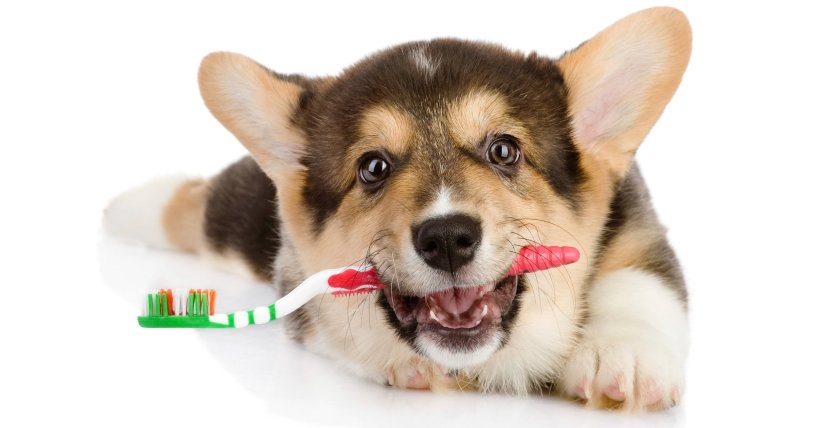
- Brush your dog’s teeth every day with a canine toothbrush and paste formulated especially for dogs.
- Start doing this when your dog is still a puppy so that he can get used to this.
- The ideal age to start is between 6 to 8 months. This happens to be when his adult teeth come in.
- With rapid tartar buildup, it’s best to visit your veterinarian as soon as possible for a dental cleaning.
- Your veterinarian will recommend dental biscuits and dry food.
- Using rubber chew toys, and ones that are made from rope and sheepskin will also help to keep Fido’s teeth clean.
Dogs and Periodontal Disease
The most problematic dental condition affecting dogs today is periodontal disease. Periodontal disease causes inflammation and infection of your dog’s gums, as well as the supporting tissue of his teeth.
You’ll notice this by seeing bacteria filled plaque and tartar (calculus) build up on his teeth, most especially underneath the gum line. Pockets then form under Fido’s gum line, which in turn results in food lodging inside the pockets. These small bits of remaining food then become breeding grounds for unhealthy bacteria.
What to Watch Out For
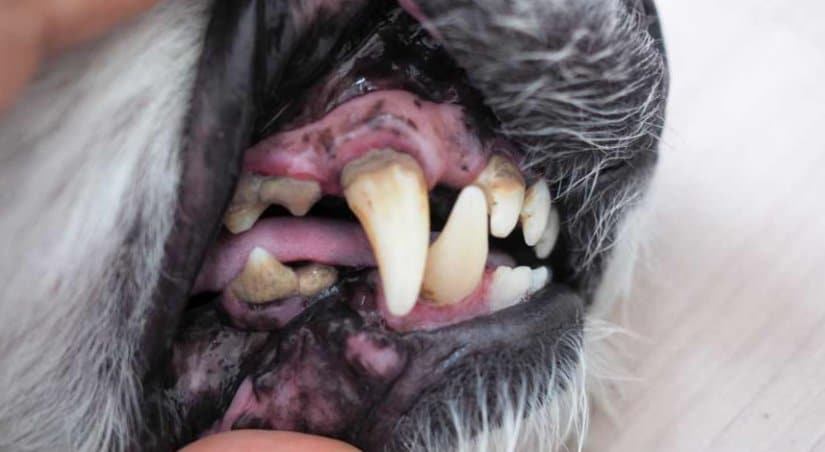
- Bad breath
- Bleeding and inflammation of the gums
- Receding gums
- Loose and painful teeth
Are All Dogs Prone to Periodontal Disease?
According to new research from the American Veterinary Dental Society, there are more than 80% of dogs that will suffer from periodontal disease. These dogs range from three years and older and have not benefited from preventative dental measures such as regular dental cleanings. All breeds are just as easily affected, although the most common breeds affected by periodontal disease are the Toy breeds.
Small breeds have the same amount of teeth as the larger breeds-42 teeth, yet their teeth are pushed together into a smaller space. Veterinarians recommend frequent dental brushing to prevent periodontal disease. It’s been proven as the best way for removing bits of food and other unwanted residue in your dog’s mouth. If this is not removed, it hardens, and then changes into unsightly brown deposits which are known as tartar.
The Latest in Periodontal Treatments for Fido
A new treatment called Doxyrobe is commonly used today to treat Fido’s periodontal disease. Doxyrobe is available in a gel form, and is placed inside the socket to increase attachment. It is prescribed in the form of a sustained /release form of doxycycline, and helps treat canine periodontal disease. Your veterinarian will prescribe this medication.

Another new dental treatment, OraVet, is a gel that can be applied weekly to stop the formation of plaque and unsightly tartar. Nonetheless, if your dog’s teeth are in very bad shape, dental specialists may recommend bone grafting and guided tissue regeneration. For more serious cases of periodontal disease, extraction is favored. Dogs that have had a tooth extracted are still able to chew on their food, and on their dog toys.
Endodontic Problems and Fido
Teeth that are broken or have abscesses will need a root canal or an extraction. Endondontic problems tend to be more common in larger dog breeds, and occur most often in breeds like the Labrador and Rottweiler breeds.
These larger breeds tend to chew on larger objects like fences, wooden furniture and outdoor garden furniture. This grinds their teeth down, and sometimes will result in a dog’s tooth being fractured or chipped. Ice cubes can also result in teeth chipping or fracturing. Keep your dogs away from any harmful chewables that could result in a tooth fracture.
How Do You Know When Fido Has Dental Problems?
Doggie Breath: If your dog’s breath smells bad, have his teeth examined by your veterinarian and professionally cleaned. You should still brush your dog’s teeth every day.
Loss of Appetite: Dogs that have pain chewing, will have problems when eating. They may pick at food, and then cease eating altogether. This may be symptomatic of periodontal disease. Visit your veterinarian immediately to get treatment.
Drooling: Fido’s excessive drooling may be a sign of a painful dental condition, or something that is stuck inside a tooth. In this case, it is necessary to take your pooch to the veterinarian as soon as possible.
You can also try to dislodge anything inside his mouth that may be hurting him. Sometimes small Terriers chew on branches, and these tend to get stuck inside their mouths. When this happens it’s best to try remove the twig or bit of wood, by sweeping your fingers through his mouth to prevent your dog from choking.
Feeling Sickly: Oral bacteria from doggie dental problems can enter Fido’s bloodstream, and can result in several health problems, some of them can be very serious, even deadly. Damage to the kidneys, heart, liver and lungs can also occur if professional veterinary dental treatment is not sought immediately. Always keep your dog’s best interests in mind. Consult with your veterinarian for any dental advice.
Does Fido Paw His Mouth and Cheek?
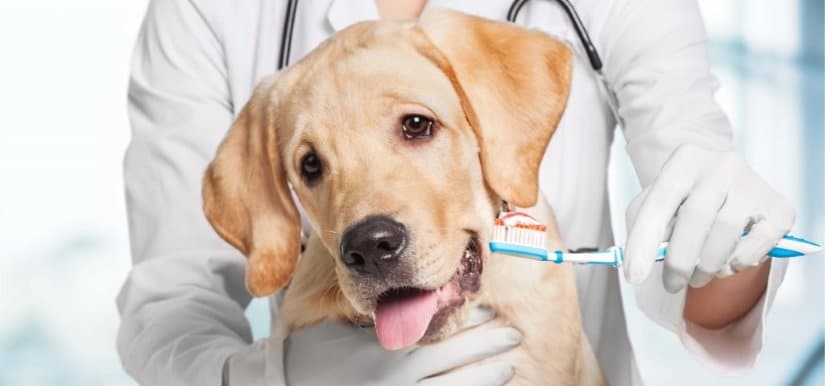
Always examine the inside of your dog’s mouth for painful ulcers and for inflamed and red gums. This has to be done quickly since dogs have limited patience when it comes to their mouth and teeth. Visit your veterinarian if the problem continues. Never ignore a dental problem, even if it does not seem to be a big deal at the time. Most dogs tend to regain their appetite and energy after a tooth repair is made. Keep in mind that a dog’s tooth pain is similar to humans.
Don’t ignore tooth pain in your dogs. It’s necessary to get the best treatment possible. Inquire about what’s involved in canine dentistry, and if your pooch will need anesthesia. If so, he will need a pre-surgery exam to ensure that he’s healthy enough to go under anesthesia. Also consider pet insurance that will cover many dental procedures.
Daily brushing will pay off in the end, ensuring healthy pearly whites and a healthier dog. Keep your pooch healthy with good dental care! It’s well worth the effort.
Like humans, dogs do get plaque on their teeth which leads to gingivitis, decay and many other problematic health issues. You’ll need to feed your pooch a healthy diet, and brush his teeth a few times a week. Many pet parents have difficulties when first brushing their dog’s teeth, and after a few tries may consider it too much of a bother to do every day.
Brushing your dog’s teeth does get easier with time, and believe it or not, some dogs really do enjoy having their teeth brushed. If you’re the pet parent to a pooch that runs away as soon as he sees the toothbrush in hand, don’t worry. Here are some easy tips to get the hang of brushing Fido’s teeth.
Easy Brushing Tips
- Buy a few canine toothbrushes, and a few different flavors of canine toothpaste from your local pet store or online.
- Before brushing your dog’s teeth, examine his mouth for any chipped or broken teeth.
- Check for any abscesses that may have occurred due to dental neglect. These are very painful, and could be dangerous for your dog’s health.
- Consult with your veterinarian immediately for any of the above conditions before brushing your dog’s teeth. You don’t want to hurt an existing condition, and your dog may associate the pain of the toothbrush against an abscess with brushing his teeth. This will make it more difficult for you in the long run, since he may run away from you when he sees you carrying his toothbrush.
- All breeds will have different sized teeth. Smaller Toy breeds will have smaller teeth compared to larger breeds like the Retriever.
- The finger toothbrush that slips over your index finger is the easiest to use. The other brush is one that looks like a human toothbrush, yet it has a larger head.
- Washcloths also may be used to wipe over your dog’s teeth.
- Only use a canine toothpaste since human toothpaste is toxic to dogs, and could kill him if ingested in large amounts. Human paste can cause liver and kidney damage. Those with xylitol cause low blood sugar in dogs, and can be life-threatening. Stay clear of all brands of human toothpaste. If you suspect that your dog has ingested any, seek immediate veterinary treatment. Doggie toothpaste is available in chicken, beef or peanut butter flavors formulated especially for dogs.
How to Brush Fido’s Teeth?
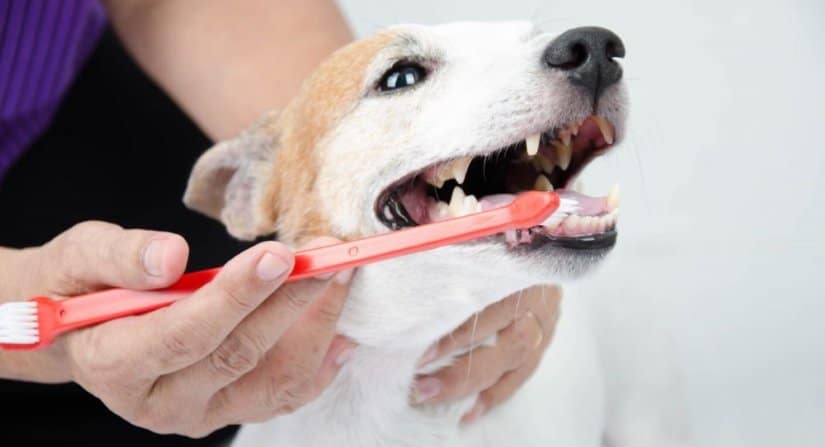
- Start of by allowing your dog to sniff the toothbrush and toothpaste. Reward with the clicker and healthy treat.
- Place a little toothpaste on your finger and allow for him to lick it off. Praise and treat.
- Gently using your finger with a tiny bit of paste, rub some on his teeth and gums working in a circular motion. Your dog needs to get used to the taste and the motion of having his teeth cleaned.
- Next, apply the canine toothpaste to his toothbrush, and begin by brushing the four outer sides of his teeth. Brush gently, close to his gums, all the while praising your dog. Continue with the next four teeth, and so forth, continuously praising him.
- As your dog begins to enjoy this, which he will, you can start brushing the inside of his teeth, and brushing more thoroughly.
- Daily brushing is important for your dog, and needs to be followed up with a professional veterinary cleaning when needed. This will be done under anesthesia, and after blood work, to see if your dog is healthy enough to have anesthesia.
- Don’t delay regular dental cleanings. Your furry best friend could end up with periodontal disease.
- Zututh has a video tutorial on their website offering easy instruction.
Dental Discounts at Your Veterinarian and Pet Boutiques
During the month of February, there may be many discounts on canine related dental products and services for pet parents to enjoy. It’s a great opportunity to buy these products in bulk and store them. Dental canine hygiene has to be made a priority, like great veterinary care and healthy nutrition, and must be practiced year –round to ensure your Fido’s well-being. Today, there are even electric toothbrushes for dogs, doggie dental floss, water additives, and tongue scrapers to keep your dog’s tongue germ free.
Canine Dental Product Brands
- Quaker Pet Group
- Silver Tails Line
- Orapup
- SER Enterprises
- Dental Cleanse for Dogs
- Ark Naturals
- Arm and Hammer Canine Oral Care
- SynergyLabs
- PlaqClnz
- Zututh
Tongue Applicators and Electric Toothbrushes
The tongue applicator for dogs made by Orapup is the first one for dogs out on the market. It serves to get rid of bad breath, without the use of a toothbrush. The tongue applicator has very soft pointed bristles that are designed to reach into the crevices of a dog’s tongue. This loosens all the foul smelling bacteria.
How Does It Work?
- Apply some cleaning paste to the applicator.
- This is made up from natural enzymes and contains 100% anti-plaque ingredients that will fortify against canine gum disease.
- The paste also helps to reduce tartar.
- By using the tongue applicator, there’s no struggle with brushing teeth.
Dental Bone Treats
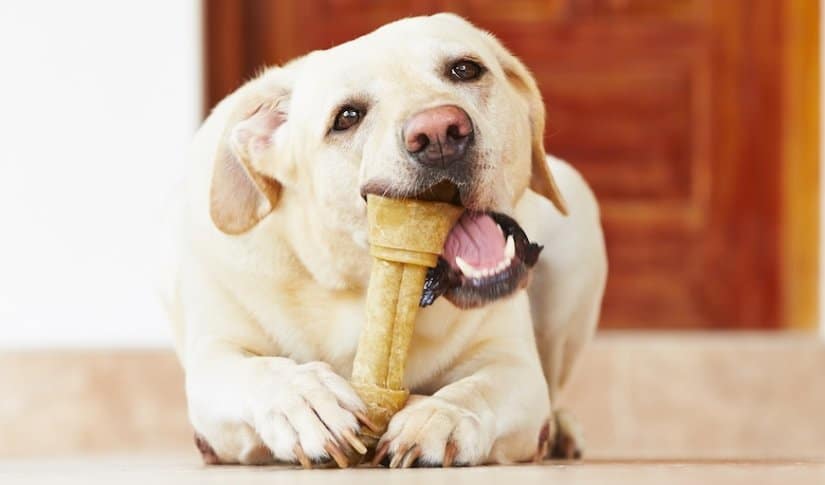
Ark Naturals has a large sized bone that helps with keeping Fido’s teeth clean. This bone has won 3 awards, and can be found in 4 sizes. It’s an easier product for your dog to digest because it’s extruded and not injection molded. This means that the bone does not break up in bits.
The outer part of the Ark Naturals bone contains natural ingredients like chlorophyll, cinnamon, clove and vanilla. The bone works by scrubbing teeth due to the way it’s designed. It has a scrub effect on Fido’s teeth, and has been highly recommended by veterinarians. The center of the bone contains 3 bacteriostats to slow down all plaque-forming bacteria. This also helps with doggie breath, tartar and plaque formation.
Today, trends in dental canine products are following a similar path to human oral care. There is a huge range of canine dental products on the market suitable for all types of breeds. There’s no reason to avoid canine dental care. Poor dental care in our furry best friends can lead to so many painful and harmful diseases. Keep your dog safe and healthy. Canine dental education is key to Fido’s well-being!
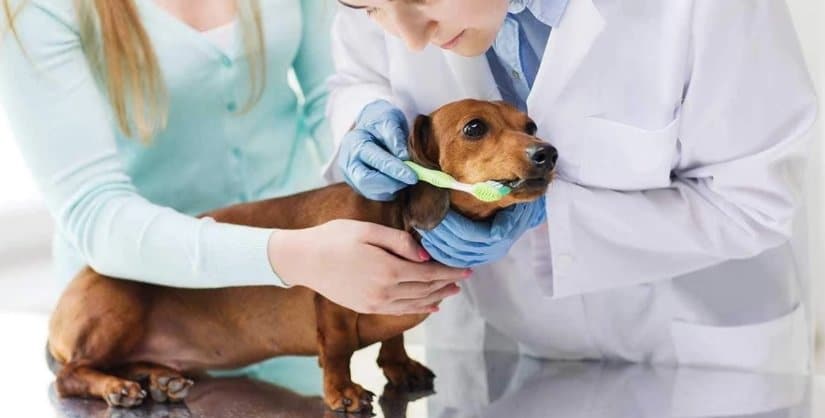
Thanks for the tip that I should brush my dog’s teeth every day with a canine toothbrush and toothpaste specifically designed for pets. I suppose it is also responsible for me to take him to a dentist to have regular cleanings done. After all, I’m tired of seeing his teeth to be very yellow, and I don’t like his bad breath at all, so I want this to stop before he enters the dog show contest next year.
Wow, it’s interesting to learn that there are professionals who can look into your dog’s teeth and make sure that they’re healthy and clean. My sister is about to get a puppy next month, and she’s looking for ways to take care of the beagle. I’ll be sure to let her know about the importance of dog dentistry.